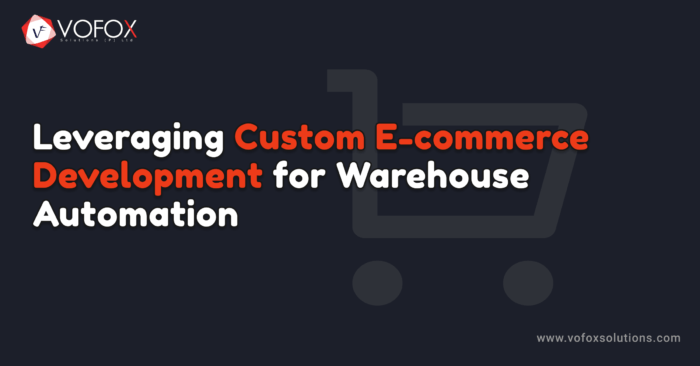- March 07, 2020 11:46 am
- by Ajanth
- March 07, 2020 11:46 am
- by Ajanth

Read this article to make the right decisions while choosing a custom eCommerce development company for your e-commerce development needs. This article will also provide you with some key insights that enable you to efficiently leverage custom ecommerce development for warehouse automation needs.
As more and more products are ordered online, the e-commerce industry is expected to outgrow retail in the near future. According to a recent study by McKinsey, the e-commerce and warehousing industry has secured third-place among the top industries that have the highest automation potential. With a majority of warehouses nowadays being operated manually, this clearly illustrates an immense potential for automation.
Let’s see why your e-commerce industry needs warehouse automation?
By automating your warehouse, you can reduce your operational cost, achieve increased control on your facility, save a lot of manpower, reduce work-related accidents, efficiently utilize space, and more importantly dodge the errors that happen due to manual handling of products. With all these advantages of warehouse automation, many e-commerce companies have not yet adopted this into their operations.
E-commerce businesses that are able to deploy automation efficiently within their warehouse can effectively overcome the common challenges such as shortage of workers, delays in orders, increased unit costs, and lack of proper forecasting that are faced by their modern-day counterparts.
Let’s analyze the common challenges in warehouse operations that are faced by e-commerce businesses.
Unemployment rates are soaring across many countries around the world. On the contrary, there is a huge decline in the size of the available workforce in the United States and some European countries, possibly due to increased labor costs and shrinking population levels.
Due to this reason, it won’t be an easy task for e-commerce companies to find high-quality workers to move products from shippers to their customers. The shortage of workers & high labor costs can be easily addressed by e-commerce companies by replacing manual labor with automated systems.
It is extremely important for every e-commerce business to maintain delivery reliability even on the busiest business hours. Lack of warehouse automation plays a major role in delaying orders. Delays in orders can also harm customer loyalty and can negatively affect your e-commerce business.
Although being a simple task, picking consumes a fair share of your annual labor budget. Failure to optimize the picking in your warehouse can have a negative effect on your overall e-commerce business. We will jot down some of the negative scenarios that you will probably encounter if you operate a warehouse that lacks picking optimization.
You can counter this issue by making slight changes to your traditional picking processes such as optimizing picking routes, prioritizing orders, and implementing a warehouse management system (WMS) into your operations. Using Radio-Frequency Identification (RFID) tags instead of traditional barcodes allows you to effectively manage and track products in your warehouse.
Radio-Frequency Identification (RFID) is a carrier technology that allows you to effectively manage and track products in your warehouse. Major players in the e-commerce industry are now adopting RFID technology for improving their warehouse operations. When integrated with a proper warehouse management system, RFID can be efficiently used to manage sorting & picking, delivery, and several other operations within your warehouse. By leveraging custom ecommerce development for warehouse automation, you can integrate all these hardware technologies into one single warehouse management system (WMS).
Lack of automation in your warehouse operations can cause manual errors that can slow down order fulfillment and shipment, this can have a negative impact on your customer satisfaction levels.
Automating your warehouse will allow your e-commerce business to efficiently tackle the challenges that we mentioned above.
Let’s see below how you can leverage custom ecommerce development for warehouse automation?
The warehouse management system has loads of essential features that help optimize order picking and tackle the common challenges that are involved in warehouse operations. Although there are tons of third-party warehouse management products available in our market, most of the successful e-commerce companies out there use a custom e-commerce warehouse management software. Developing a custom-built WMS with the help of a custom ecommerce development company can help your business to accelerate its operational efficiency thereby bringing a positive impact on your revenue.
Warehouse automation has replaced conventional equipment such as conveyor belts, forklifts, etc with automated facilities such as Automatic Guided Vehicles (AGV), Drones, Automated Retrieval System, etc. A Warehouse Control System (WCS) is nothing but an integrated interface that has direct control over this equipment.
Warehouse Execution System (WES) is an end to end software that combines some of the features of both WMS and WCS. Warehouse Execution System can be best suited for e-commerce startups and medium-sized e-commerce businesses.
When it comes to warehouse management, warehouse automation is the next big thing. Ready-made warehouse management software often misses features that are specific to your business needs like handheld terminals for scanning barcodes, RFIDs, or integration with other hardware. So the best way to tackle these warehouse management challenges is by building a custom warehouse management application.
For many e-commerce businesses, developing a custom warehouse management solution in their inhouse development facility will be a challenge as it requires lots of time and skilled resources. Because of this, it’s better to approach an experienced custom e-commerce development company for your development needs.
Guaranteed Response within One Business Day!

How Much Does It Cost to Design an App?

Angular Best Practices For Web Applications

How to Set Up a Development Environment in React.JS?

What are the 6 Models Used In SDLC?

Why React Front-End Development is the Best